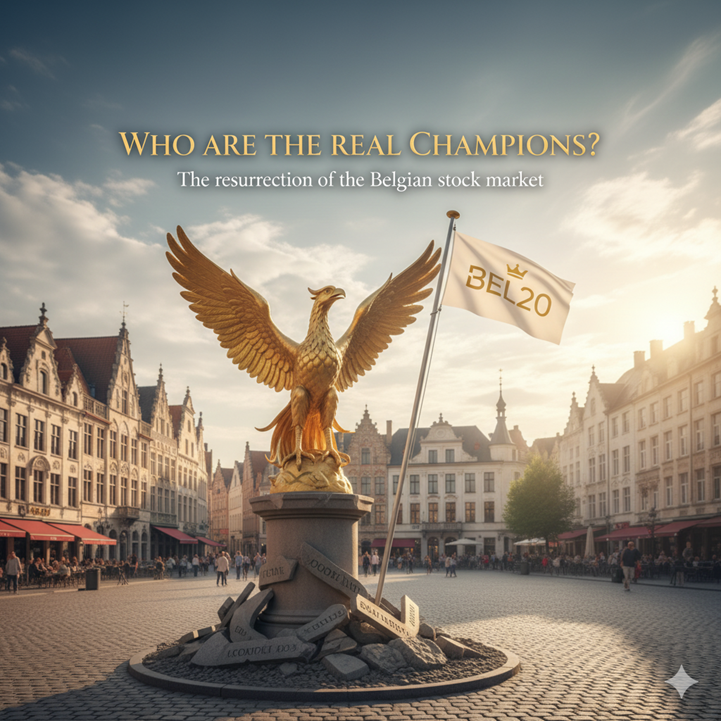Danny Van Quaethem has a master’s degree in Germanic Philology (English-German) at RU Gent. Then he obtained the diploma of financial analyst (ABAF). He wrote for ten years for investment magazines (7 years for Afinas Report and 3 years for De Belegger). In 1997 he started at Société Générale Private Banking Belgium (formerly Bank De Maertelaere). He worked exclusively as a financial analyst covering equity markets, focusing on a number of sectors (pharmaceuticals, chemicals, consumer goods). At Econopolis, Danny is Senior Equity Analyst.
Who are the Real Champions?
Reminiscences of an analyst: the resurrection of the Belgian stock market


Image generated by Gemini
Beautiful Bel20
Year-to-date, the Bel20 net return index delivered a return of roughly 18%. That is almost as much as the Nasdaq composite (+22.8%) and better than the S&P 500 (+17%), excluding the 10% drop of the US dollar. Returns vary strongly amongst indices and within indices. Volatility remains high and a week can make a big difference. Performance reviews also have an arbitrary nature, depending on the starting date. When a stock or an index happens to close the year at an absolute low, chances are it might perform nicely the ensuing year. But there are no guarantees, of course. Ultimately, stock performance is driven by earnings, interest rates and money available (liquidity). In that sense, it is wondrous how well Belgian stocks have performed despite continued outflows and disinterest. The number of funds that focuses on Belgian equities has dwindled, and so has interest from the professional investment community. European stocks overall have been in the oubliette. Money simply flows to where earnings grow steepest and that happens to be in the US. The earnings development at a lot of major European companies has been shockingly bad over the past fifteen years. Whether it’s AB Inbev, BASF, Heineken, Henkel, Nestlé or a lot of major pharma companies: earnings have been going nowhere. Average earnings growth in Europe in 2025 is… zero. In the last twenty years, there has been huge value destruction in Europe, especially in Germany because of loss of competitive edge, because of ill-fated acquisitions or because of fraud (Daimler/Chrysler, Vodafone/Mannesman, Bayer/Monsanto, Wirecard). Across the Ocean, the US is piling on multitrillion dollar companies. Symbolically, Nvidia surpassed the 5 trillion dollar market cap. It is worth more than the stock markets of France, Germany and Italy combined. To put things into perspective, a 2% share price movement of Nvidia represents about the total market capitalization of AB Inbev. And yet, AB Inbev harvests more than a quarter of all profits in the global beer market.
The US also knew its part of fraud (Enron, Worldcom and many smaller ones), suffered a deep tech recession after the 2000-bubble followed by the 9/11 terror shock, but thanks to its relentless “can do” mentality and its technological and scientific leadership the US invented and built itself a bright future. In recent years, the superiority of the US has become all to evident while Europe is going through an existential crisis. The same could be said about Belgium. Investors were first traumatized by the fraud of Lernout & Hauspie and the tech-crash in the early 2000s, then nearly smacked to death by the financial crisis of 2009 (with the demise of Dexia, Fortis), followed by the Euro crisis (2010-2012) and to finish it off, they experienced the Covid and Ukraine crisis.
Despite all these shocks the Bel20 recently hit an all-time high. The rally started on 21st of March, 2024 when the index broke a downward trend with a rise of 2.8%. The Bel20 rallied 35.7% from its close on 20st March 2024 till the new high of 5000 points with only one serious hiccup, the “Liberation day correction” of April 2025. The rally was owed to only a handful of stocks. Over that same period UCB is up 118%, Argenx 113%, KBC 50%, Ageas 42% and Ackermans 38%. Yes, little Belgium has its growth stocks too. Taking into account dividends, the total return is even more impressive: Bel20 41.5%, UCB 122%, Argenx 113% (no dividends), KBC 67%, Ageas 58%, Cofinimmo 57% and Ackermans 43%.
Earnings, earnings, earnings
Earnings growth for these companies has been very strong and even explosive in the case of UCB (+19% in 2024, +55% in 2025E) and Argenx (first profit expected in 2025 of 1 bn USD and 58% growth expected in 2026). KBC realized a consistent high-single digit earnings per share growth. Fun fact: Refinitiv consensus net profit for 2025 is 8.47 EUR per share. That is exactly the adjusted earnings number that was produced in 2007. To proof our point – stock prices track earnings -, the share price of KBC is currently back around levels last seen in… 2007. The analyst consensus expects earnings growth of 10% and 9.5% for 2026 and 2027, respectively. If KBC realizes this growth, that would be no less than spectacular. The group survived the Great Financial Crisis thanks to the support of the state, which was richly remunerated. That excruciatingly painful lesson ultimately resulted in a much stronger group. KBC is now applauded for its leading digital strategy (Kate) and has a key position in the strongly growing Central European markets. KBC is up 38% year-to-date, but oddly enough it “underperforms” its European banking peers (with many banks up 50 to 100%). KBC profited less from the ECB-interest rate manna, but should see better relative earnings performance in 2026 and 2027. Ageas is more difficult to judge as numbers for an insurance company are never straightforward. Nevertheless, Ageas has built a superb track record when it rose like a phoenix from the ashes of Fortis. While leaning on its cash-generating Belgian position and strongly growing Asian division, it first sorted out the old Fortis litigation mess. Then it built up its market position in Portugal, while at the same time addressing the lingering problems in the UK. As a sign of renewed strength, Ageas is back on the acquisition trail. It failed to acquire Direct Line. But in April 2025, Azure bought the British insurer esure for 1.5 bn EUR in cash, creating the third largest UK personal lines platform. The jury is still out on the success of this acquisition, but the fact that Ageas dared to take such a bold step shows the confidence of management in its long-term strategy. This is an attitude seen at the other companies as well. KBC acquired 365.bank in Slovakia for 761 mln EUR. And UCB re-invented itself thanks to several acquisitions. Because UCB plays a crucial role in the Belgian stock market, it is worthwhile to take a step back thinking about why UCB has become so successful.
UCB: the secret of aging well
In fact, UCB has an incredible history. It is the most successful Belgian spin-off ever! It started in 1928 with Emmanuel Janssen founding Union Chimique Belge (UCB) as a spin-off of Solvay, initially focusing on industrial chemicals. In the 1950s, UCB established a research center, leading to the development of Atarax (hydroxyzine), a drug against anxiety that is used to this day. In the 1970s, UCB's pharmaceutical division developed piracetam, marketed as Nootropil for memory and balance problems. The success of Nootropil made it possible to build a modern pharmaceutical site in Braine-l'Alleud, south of Brussels. Fast forward to 1987/89, when UCB launched its first blockbuster, the antihistamine Zyrtec. Zyrtec was commercialized in the US by Pfizer. It reached peak sales of around 1.6 billion dollars. UCB re-invested that money smartly. It became the leading company in epilepsy-treatment, thanks to its blockbuster drug Keppra (levetiracetam). What makes the company exceptional, is how it re-invented itself many times over. It acquired expertise and new products through a string of acquisitions. The major ones were Celltech in 2004, then the leading British biotech company with great monoclonal antibody expertise. Today, Shlough in the UK is UCB’s R&D centre of expertise for large molecules. In 2005, UCB sold Cytec (surface specialities), becoming a pure biopharmaceutical group. Ironically, Cytec is now back in the hands of Syensqo, another “spin-off from Solvay. In 2006, UCB put 4 billion EUR on the table for Schwarz Pharma, a German drug company that brought it two epilepsy drugs (Neupro, Vimpat). In 2020, UCB spent 2.1 billion euro to buy Ra Pharma. The impact is a bit similar to what we saw with Celltech. UCB not only acquired a promising new molecule (zilucoplan), but also a research hub in the US. Ra Pharma’s propriety peptide research and development unit in Cambridge, MA added to UCB’s network and presence in Massachusetts and the greater Boston area. Ra was specialized in the complement system, a critical component of the innate immune system. Finally, UCB dug out 1.7 billion euro for Zogenix in 2022, that brought Fintepla (fenfluramine), an oral drug for severe epilepsy. We did not mention several smaller acquisitions. Just one that may prove critical in the coming years: in 2020, UCB also acquired Handl Therapeutics, a spin-off from the university of Leuven. Handl specializes in transformative gene therapy. For the moment, nothing is visible in UCB’s pipeline. But chances are that Handl will become the source of significant new product innovation in the next ten years.
UCB: no crimes against innovation
UCB contributed to a fantastic podcast “Hypothesize that! Crimes against Innovation” (https://www.ucb.com/innovation, available on Spotify). When a professor at Stanford was asked what the biggest crime was against innovation, he instantly mentioned “Milestones”. The point he made is that results in science cannot be predicted nor forced, so there is no point in putting time pressure on scientists. Only when a molecule enters the development phase it becomes an engineering project where one can have clear milestones. The key message of the professor was that it takes real regular communication between a company and a university team, so that these collaborations do work in practice. According to Alistair Henry, UCB’s chief scientist, the biggest crime against innovation is over-resourcing. That is a way to kill creative thinking. There’s no point in doing more of the same thing. You must force people to think differently. Then they come up with new ideas, they innovate. The old saying “scarcity is the mother of invention” still seems valid. It creates bound risk-taking, focus and a wish to win against the odds. This attitude might partially explain why “small” Belgian companies like UCB and Argenx succeed in bringing true innovation, where a lot of giant pharma companies struggle despite having massive R&D budgets.
UCB: that’s the way to do it
UCB shows a number of characteristics. First and foremost, the extra-ordinarily importance of a dedicated family-shareholder cannot be underestimated. The company remained safely into Belgian hands, whereas so many of our crown jewels were unfortunately sold in the past. What is equally remarkable, is how well-managed the company always has been. Good corporate governance matters. The board focuses on the long term and appoints capable management. The family shareholders represent patient money, but also smart money. UCB has continuously built on the knowledge it acquired, step by step. Now it has not only become a research and development powerhouse, but it also is a strong commercial organization with a proven marketing prowess.
After studying UCB for 38 years, we finally understand and appreciate the company’s awesome DNA. On a scale from 1 to 10, we give UCB a 12. And with that, we conclude that rumours of the death of the Belgian stock market are greatly exaggerated. Because UCB is not alone. Equally exciting stories can and will be told about other Belgian companies.
